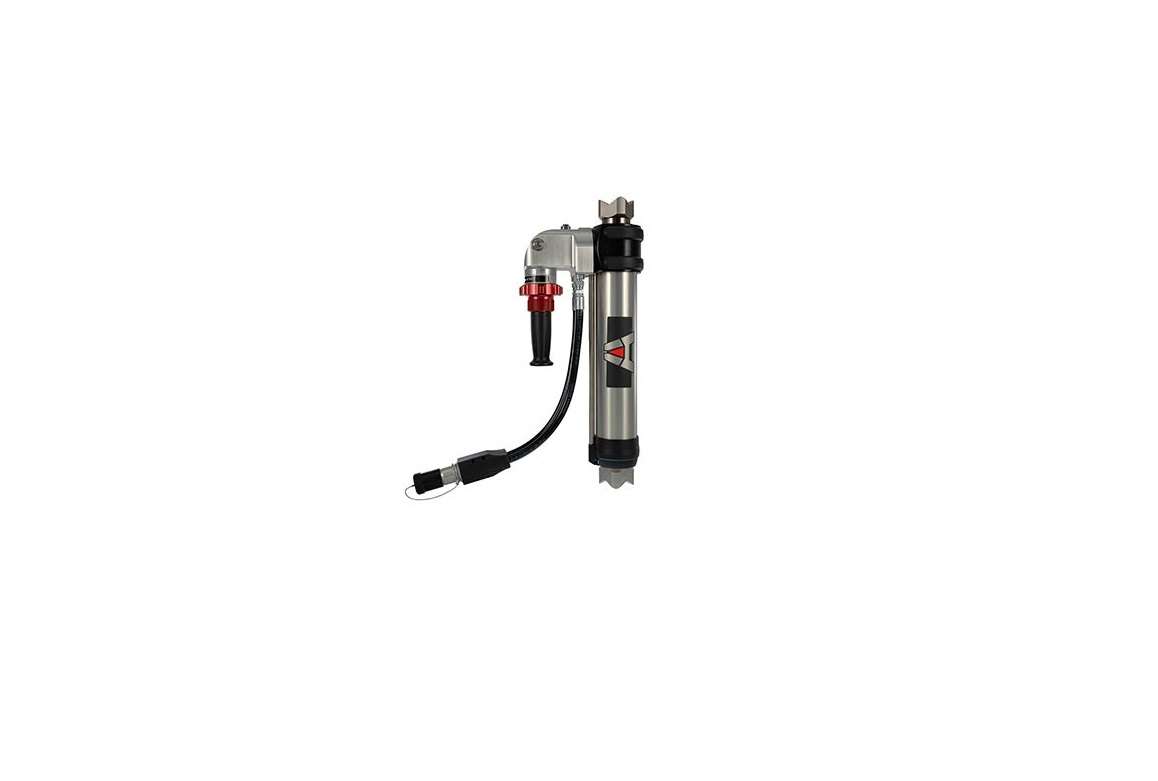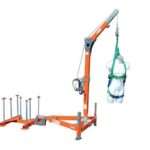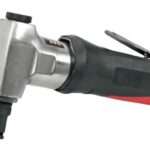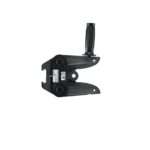AMKUS TR500 Hydraulic Rescue Tools User Manual

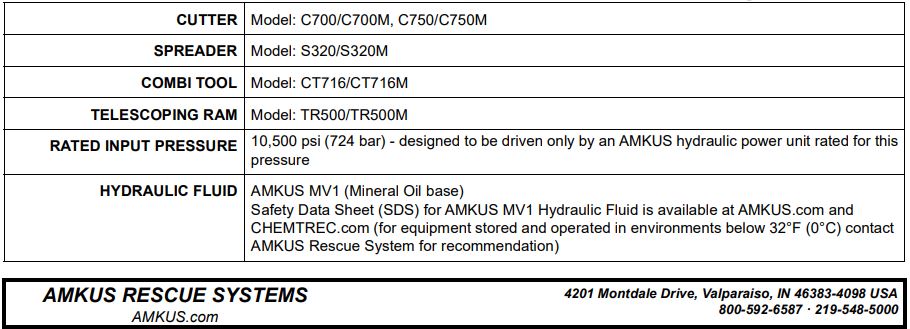
SUPPORTING MATERIALS
This Safety Manual is not intended as a substitute for proper training in the use of rescue systems as taught from credible sources such as the National Fire Protection Association (NFPA), The International Fire Service Training Association (IFSTA), or sources approved by the Authority Having Jurisdiction (AHJ). Examples of recent publications:

1.0 MEANING OF SAFETY SIGNAL WORDS
A safety related message is identified by a safety alert symbol and a signal word to indicate the level of risk involved with a particular hazard. Per ANSI Z535.6, the definitions of the four signal words are as follows:

2.0 SAFETY
![]()
Hydraulic tools apply many tons of force. The forces may bend, move, or lift large loads while storing potential energy. Loads can become unstable and suddenly move without warning causing severe injury or death. Never support a load solely by a rescue tool. Use secondary supports to limit the extent of uncontrolled movements. Never put body parts in a situation where a shifting or falling load can cause a crushing injury. Stay clear of the path of travel.
- Metal-on-metal contact is likely to slide sideways when the load is not able to deform around the area of contact. Use care when lifting structural and hardened objects.
- Chains can break when overloaded or improperly loaded.
- Spreader tips and rams can kick (move) when direction of force isn’t perpendicular to load
- Loads can suddenly shift sideways when forced, lifted, or moved. Stabilize load to reduce risk of movement from ice, gravel, soft ground, precarious positions, objects which can break, wheels which depressurize or roll, and loading which can change during rescue operations.
![]()
Operating rescue tools can result in injury or death from laceration, projectile (high speed flying debris), and pinch point injuries. Stay clear of the path of travel. Avoid unnecessary risk. Examples include:
- Never lift, or hold a rescue tool by its cutting blades, spreader arms, or ram pistons. Never place hands between moving tool and a load. Pinch points are created from tool movement causing risk of limb amputation (i.e. fingers, hands, arms, feet, legs).
- Sharp metal objects formed during cutting and extrication cause potential for laceration and puncture wounds
- Projectiles can be ejected during cutting, spreading, or lifting operations when objects break suddenly under load. Sudden fractures are common with springs and hardened steels.
- Damaging pressurized objects such as airbag cylinders can create projectiles.
- Using a rescue tool beyond its reasonable lifespan increases risk of fatigue failure. Expected lifetime of the tool is 10 years from the date of manufacture.
- Tools can drift (move side-to-side) as load is applied or released resulting in body parts being trapped and crushed between tool handles and stationary objects. Always be aware of body, hand, and finger position. Stop before harmful contact is made.
![]()
Using rescue tools can cause ignition or explosion resulting in injury or death. Ignition or explosion can result from situations such as:
- Flammable hazards are created when fuel lines, refrigerant lines (atomized oil), or pressurized hydraulic fluid lines are breached. Ignition sources can suddenly ignite these fuels.
- Flammable vapours can be released by careless refuelling or operation of gasoline driven engines. Refer to engine manufacturer’s manuals for specific details.
- Extrication tools can create sparks as metals are cut and deformed. Avoid unnecessary risk when flammable vapours are present.
- Power units with electric motors or internal combustion engines are ignition sources. Flammable vapours heavier than air can accumulate in low spots. Avoid selecting these locations when setting up the power units. Use detectors to verify safe site selection.
![]() Hydraulic fluid (mineral oil) escaping under pressure can puncture the skin, infiltrate eyes, or lungs resulting in serious injury. Seek medical attention immediately. Avoid the urge to contain leaks with hands. Injection injuries require immediate medical attention. Safety Data Sheet (SDS) for AMKUS MV1 and AMKUS MV0 Hydraulic Fluid is available at AMKUS.com and CHEMTREC.com Hydraulic leaks can occur from situations such as:
Hydraulic fluid (mineral oil) escaping under pressure can puncture the skin, infiltrate eyes, or lungs resulting in serious injury. Seek medical attention immediately. Avoid the urge to contain leaks with hands. Injection injuries require immediate medical attention. Safety Data Sheet (SDS) for AMKUS MV1 and AMKUS MV0 Hydraulic Fluid is available at AMKUS.com and CHEMTREC.com Hydraulic leaks can occur from situations such as:
- Leaks at hose crimps and connections can develop from constant use, over-pressurization, side-loading, or mis-crimping.
- Hose damage from being driven over, stepped on, twisted, kinked, crushed, excessive vibration, abuse, or neglect.
- Leaks and breaks in hydraulic components can occur from improper maintenance or exceeding service life expectations. Establish sound practices.
- Connecting hydraulic tools in series can pressurize both sides of double acting cylinders. Each tool must be separately connected to a power unit.
- Release stored pressure before servicing tools by moving off end stops. Refer to power unit manuals for proper operation.
![]() Electric shock can result in injury or death. Rescue tools are made from metal which is a conductor of electricity. Electric current can flow from the hazard through the rescue tool to shock nearby people. Maintain awareness of potential hazards. Examples include:
Electric shock can result in injury or death. Rescue tools are made from metal which is a conductor of electricity. Electric current can flow from the hazard through the rescue tool to shock nearby people. Maintain awareness of potential hazards. Examples include:
- Never operate electric power units with damaged power cords.
- Do not drive over or crush power cords.
- Use care to avoid cutting power cords on sharp objects.
- Do not strain cords during storage. Hidden cord damage can remain undetected until wet conditions create an electrocution hazard.
- Power sources and electronics are not waterproof. Do not submerge or douse the power units or controls. Refer to manuals from battery, charger, and motor manufacturers for specific details.
- Cutting into concealed spaces can be hazardous. Power cables and battery packs may be hidden from view in structures and electric vehicles.
- Never operate near damaged electric power lines before power is verified as OFF.
![]() Misuse of AMKUS Rescue Systems can result in a wide variety of hazards and consequences. Remain aware of and avoid misuse situations. Examples of misuse include:
Misuse of AMKUS Rescue Systems can result in a wide variety of hazards and consequences. Remain aware of and avoid misuse situations. Examples of misuse include:
- Using low pressure (5000 psi) tools on high pressure (10,500 psi) hydraulic power units creates high risk of hydraulic cylinder rupture. Ensure compatibility before use.
- Failure to inspect and properly maintain rescue equipment. Inspect all rescue equipment after each use. Any equipment found damaged or inoperable should be removed from service.
- Storage of rescue equipment in adverse conditions. Always store rescue equipment in clean, dry, and secure conditions.
- Operation of rescue equipment with missing or illegible safety markings
- Modification of tools and power units inconsistent with manufacturer’s specifications
- Repairs attempted by unqualified technicians.
- Use of rescue tools for non-rescue purposes such as construction, production use, demolition, or as a jack for vehicle service.
- Pressure relief valve set over +5% above the Rated Output Pressure 10,500 psi (724 bar)
- Using tools which have been heat damaged. Heating beyond 212°F (100°C) will compromise the strength.
![]() Lifting or moving rescue tools and power units can result in falling or spine injury. Rescue tools and power units are heavy. Risk of injury increases in unfavourable conditions such as poor lighting, inclines, loose, wet, or icy surfaces. Follow accepted safe lifting practices.
Lifting or moving rescue tools and power units can result in falling or spine injury. Rescue tools and power units are heavy. Risk of injury increases in unfavourable conditions such as poor lighting, inclines, loose, wet, or icy surfaces. Follow accepted safe lifting practices.
![]() Use of hydraulic fluids other than AMKUS MV1 or MV0 (see Specifications for fluid for specific tool lines) can result in equipment damage and loss of function. Some examples include:
Use of hydraulic fluids other than AMKUS MV1 or MV0 (see Specifications for fluid for specific tool lines) can result in equipment damage and loss of function. Some examples include:
- Phosphate ester hydraulic fluids and blends are incompatible with Buna-N seal and hose materials used in AMKUS Rescue Systems
Mixing glycol with mineral oils can result in gelling and plugging of pump inlet screens
Using fluids with wrong viscosity or wear properties. Always use AMKUS MV1 or MV0 as specified for your tools.
3.0 GENERAL DESCRIPTION
AMKUS manufactures a complete line of hydraulic rescue tools. These rescue tools continue the AMKUS tradition of superior craftsmanship and quality. AMKUS backs these tools with a standard warranty published on the AMKUS website.
AMKUS tools are designed to be driven only by an AMKUS hydraulic power unit. Hydraulic fluid from the pump passes through a user operated control valve and moves the piston as directed by the user. Moving the piston actuates the arms or blades of the rescue tool.
3.1 VARIOUS MODELS AND TERMS

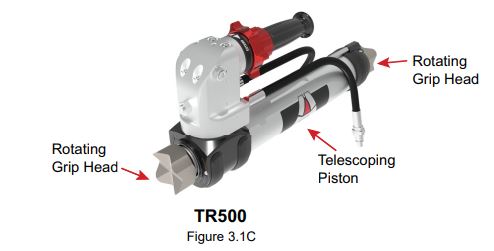
3.2 SAFETY MARKINGS

4.0 SPECIFICATIONS
4.1 GENERAL SPECIFICATIONS

4.2 CUTTER SPECIFICATIONS

4.3 SPREADER SPECIFICATIONS

4.4 COMBI TOOL SPECIFICATIONS

4.5 TELESCOPING RAM SPECIFICATIONS

5.0 SAFETY CONSIDERATIONS
5.1 PROTECTIVE CLOTHING
![]() It is the responsibility of tool operators to ensure the use of appropriate protective clothing and equipment. The chosen protective clothing and equipment must provide protection from potential hazards users may encounter while operating AMKUS rescue tools. Requirements for protective clothing and equipment are determined by the Authority Having Jurisdiction (AHJ).
It is the responsibility of tool operators to ensure the use of appropriate protective clothing and equipment. The chosen protective clothing and equipment must provide protection from potential hazards users may encounter while operating AMKUS rescue tools. Requirements for protective clothing and equipment are determined by the Authority Having Jurisdiction (AHJ).
5.2 TRAINING
AMKUS tools facilitate the extrication of entrapment victims. Only trained emergency services personnel should attempt victim extrication. All personnel using AMKUS rescue tools are assumed to have completed a training course covering safe extrication of entrapment victims. The training must be acknowledged as educationally sound by the local Authority Having Jurisdiction (AHJ) over such training.
5.3 OPERATING CONSIDERATIONS
![]()
AMKUS tools are intended for intermittent use. Allow sufficiently long pauses for the rescue tool to cool. If the tool’s exterior becomes too hot to touch, the temperature is likely above 120°F (49°C). An overheated rescue tool operates less effectively. When hydraulic oil temperature reaches 158°F (70°C), the tool’s efficiency drops significantly, and the tool should be stopped to cool down.
To avoid rescue tool overheating:
- After use, clean off any accumulated oil, grease, dirt, or corrosive substances with a damp cloth and soapy water.
![]()
Operating the rescue tool continuously against an end stop may cause overheating resulting in an inoperable tool. Permanent damage to the tool may occur. When an end stop is reached, release the control handle to return the control to the neutral position.
6.0 SET-UP PROCEDURE
Normally, AMKUS equipment is prepared and serviced by your dealer prior to delivery. If, however, you have decided to place the equipment into service yourself, remove equipment from the packing cartons and carefully inspect for damage. Damage that occurs during shipment should be reported immediately to the carrier.
- Gather and review all safety and use documentation prior to operating any rescue tool.
- Connect the tool connection hoses to the hose lines from the AMKUS hydraulic power unit.
A. Standard Couplings: Please note that the male and female couplings on the hose lines leading from the power unit should be connected to the corresponding male and female couplings on the tool connection hoses. To connect the couplings, twist the sleeve on the female coupling so that the notch in the sleeve lines up with the pin. Push the sleeve back so the pin fits into the notch. While holding the sleeve back, push the male coupling into the female coupling. Release the sleeve; it will spring forward into place. Twist the sleeve 1/4 turn so that the pin no longer lines up with the notch. Pull on the couplings to check that they are securely connected.
B. Mono Couplings: Please note that the female coupling on the hose lines leading from the power unit should be connected to the corresponding male coupling on the tool connection hoses. To connect the couplings, place the male coupling into the female coupling. Rotate clockwise until you feel the coupling latch. Pull on the couplings to check that they are securely connected.
In most cases, the Mono Couplings can be connected and disconnected while the hose line is under flow. It is usually not necessary to place the directional control of the power unit in the neutral position before connecting and disconnecting. However, certain circumstances such as back pressure in the return line and/or cold temperatures, may make connecting and disconnecting under flow extremely difficult or impossible. If you are unable to connect and disconnect while the line is under flow, place the directional control valve of the power unit in the neutral position and then disconnect or connect.
6.1 ROTATING HANDLE
Cutter and Combi Tools come equipped with a 360° swivelling handle that has variable tension.

6.1.1 HANDLE LIGHTS
AMKUS dual handle lights operate in one of two modes, an on/off mode (standard), or an optional mode with three intensity levels.
To operate the lights in the on/off mode, press the power button to turn the lights on. Press the button again to turn off.
To operate the lights in the three intensity level mode, press the power button to turn the lights on. Press the button to scroll through the three intensity levels and then off.
To change between operating modes: 1. Press the button once to turn on the lights. 2. Press and hold the button until the lights flash.
The lights now operate in the alternate mode.
7.0 OPERATION
![]() Do not connect tools in series. Connecting tools in series could cause operational problems, equipment failure, or catastrophic failure of the equipment resulting in serious injury or death.
Do not connect tools in series. Connecting tools in series could cause operational problems, equipment failure, or catastrophic failure of the equipment resulting in serious injury or death.
Start the power unit (refer to power unit and engine manuals). Following the instructions in the power unit manual, operate the selector valve to charge the hose line to which the tool is connected. Pick up the tool, noticing that the design of the cutter makes it natural to grip the handle with one hand and the control valve hand grip with the other.
7.1 CONTROL VALVE ACTUATOR
The control valve actuator has three positions, OPEN, OFF, and CLOSE. The control valve actuator includes a deadman safety feature which returns the control valve actuator to the OFF position (neutral) when released. When the control valve is in the OFF position, the tool movement stops, and holds position and load. Verify operation of control valve actuator by checking to see it returns automatically to the neutral position when released.
7.2 CUTTING
Rotating the control valve actuator regulates the hydraulic flow rate and power delivered to the tool. Turning the control valve actuator to the end stops provides maximum hydraulic flow rate and power.

To perform a cutting operation, first, open the cutter blades. Place the blades around the object being cut. Close the blades to cut the object. Obtain the maximum cutting forces nearest the pivot point. Start the cut with the blades as fully engaged as possible. Make the cut. Open the blades and remove the tool when finished.
![]() When operating the cutter, take care to be positioned to the side of the cutter. As the cutter blades meet resistance, the rescue tool may rotate or drift. If tool rotation places the user, operator, or When others in jeopardy, immediately release the control valve actuator. The deadman safety feature of the control valve actuator should immediately return the control valve actuator to the center (neutral) position stopping blade movement. Reposition the cutter as needed for optimal cutting performance.
When operating the cutter, take care to be positioned to the side of the cutter. As the cutter blades meet resistance, the rescue tool may rotate or drift. If tool rotation places the user, operator, or When others in jeopardy, immediately release the control valve actuator. The deadman safety feature of the control valve actuator should immediately return the control valve actuator to the center (neutral) position stopping blade movement. Reposition the cutter as needed for optimal cutting performance.
![]() Blades can break if positioned incorrectly, causing hazardous projectiles and an inoperable tool. If blades start to flex sideways (tool rolls as space between blades increases), stop immediately and reconsider cutting strategies.
Blades can break if positioned incorrectly, causing hazardous projectiles and an inoperable tool. If blades start to flex sideways (tool rolls as space between blades increases), stop immediately and reconsider cutting strategies.
![]() The blades on AMKUS cutters effectively cut steering columns, brake pedals, door mechanisms, and other vehicle items as necessary for extrication. However, using AMKUS cutters as a piercing tool for heavy metal is not recommended. Therefore, when cutting, take care to insure the blade tips move through a clear path of travel. The blade tips can pierce automotive sheet metal body panels. Avoid obstacles like the heavy metal backing plates hidden behind seat belt mounts, door hinges, and latching mechanisms or locks.
The blades on AMKUS cutters effectively cut steering columns, brake pedals, door mechanisms, and other vehicle items as necessary for extrication. However, using AMKUS cutters as a piercing tool for heavy metal is not recommended. Therefore, when cutting, take care to insure the blade tips move through a clear path of travel. The blade tips can pierce automotive sheet metal body panels. Avoid obstacles like the heavy metal backing plates hidden behind seat belt mounts, door hinges, and latching mechanisms or locks.
![]() Cutting hardened metals can potentially dent or deform the blade’s cutting edge. Blades may break at these weak spots on subsequent cuts, especially if cutting near the tips. Avoid cutting hardened solids of unknown strength such as:
Cutting hardened metals can potentially dent or deform the blade’s cutting edge. Blades may break at these weak spots on subsequent cuts, especially if cutting near the tips. Avoid cutting hardened solids of unknown strength such as:
- Padlock shackles
- Tie rods
- Leaf springs
- Spindles
- Hardened bolts
- Tool steel
- Heat treated chain
Blade damage or breakage that results from cutting hardened metals or solids is not covered by the AMKUS Rescue Systems warranty. The blades are intended and designed to cut hardened auto bodies and components without damage. We recommend an Authorized AMKUS Rescue Systems Dealer inspect, evaluate, and replace dented or damaged blades as necessary.
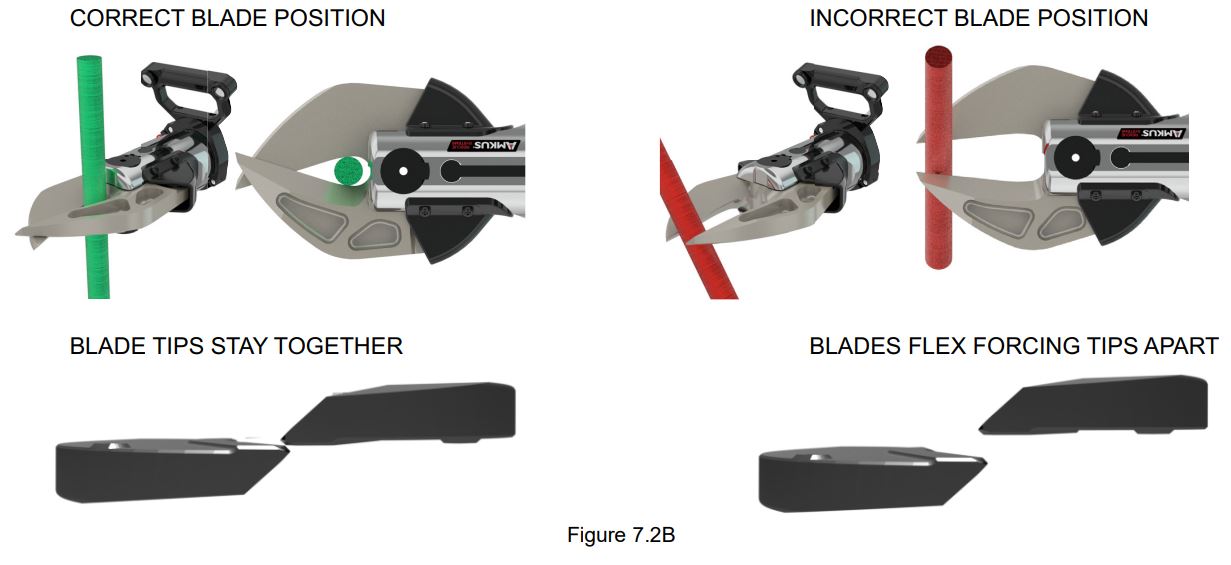
7.3 SPREADING / SQUEEZING / LIFTING
Rotating the control valve actuator regulates the hydraulic flow rate and power delivered to the tool. Turning the control valve actuator to the end stops provides maximum hydraulic flow rate and power.
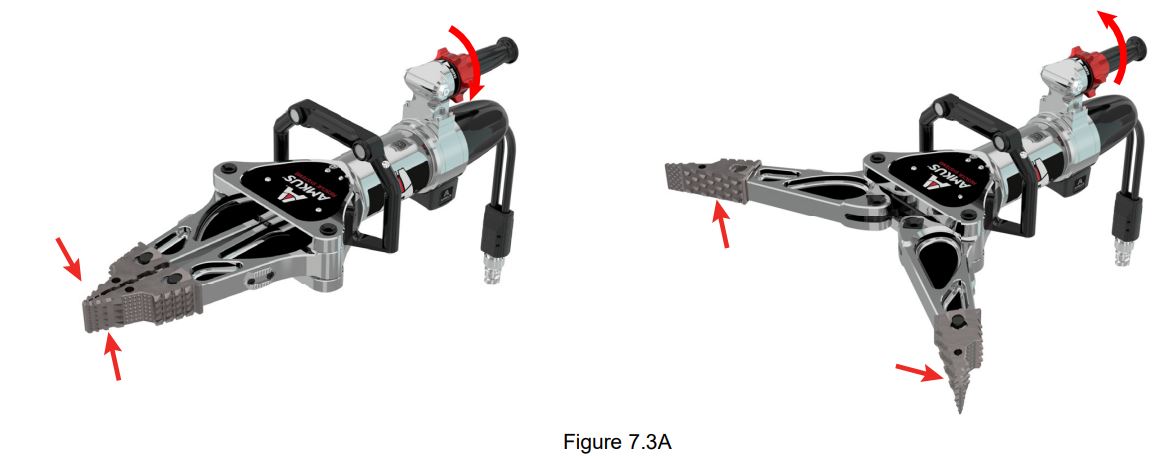
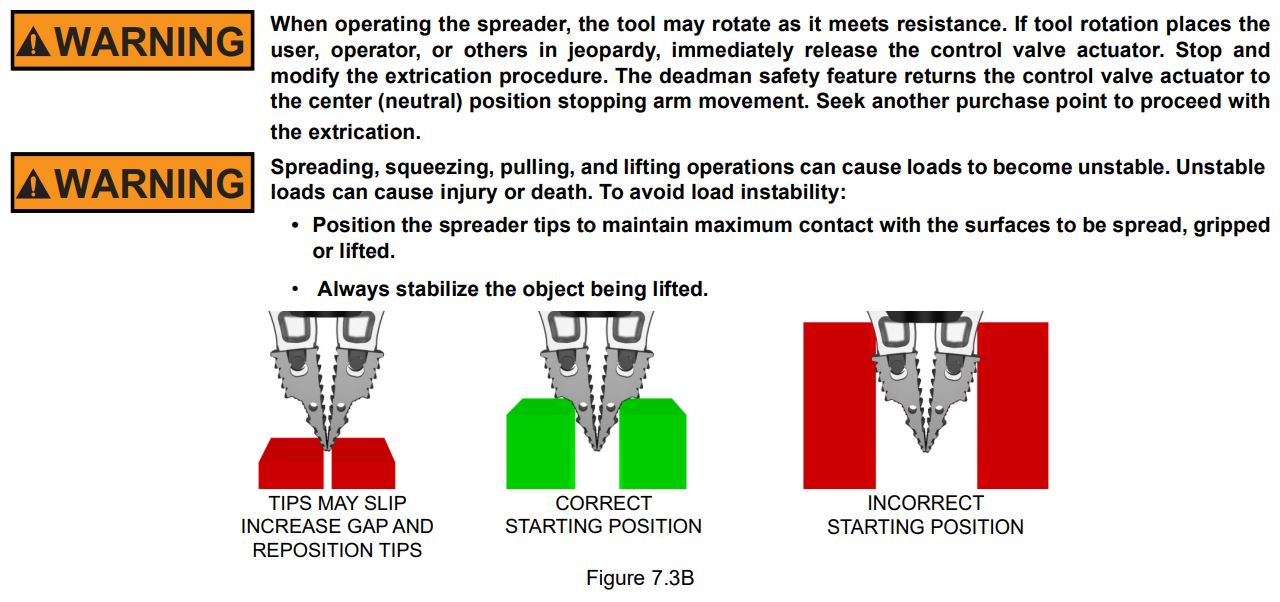
7.4 TELESCOPING RAM OPERATION
The telescoping ram has two stages that extend out in sequence. The first stage has a higher force than the second stage due to its larger diameter.
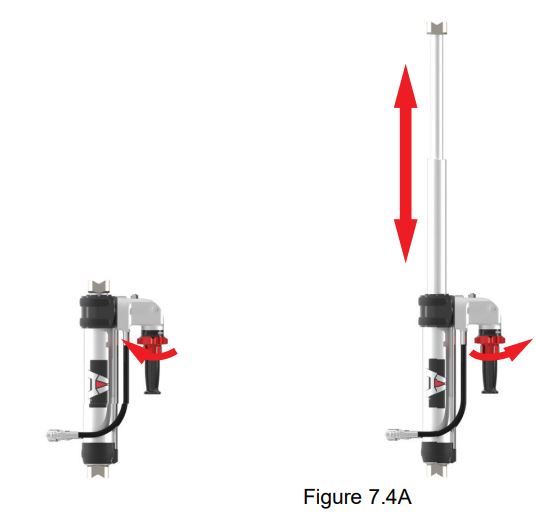
![]() Crushing from falling or rolling loads may result in injury or death. To reduce risk, observe the following:
Crushing from falling or rolling loads may result in injury or death. To reduce risk, observe the following:
- Identify the crush zone. These are areas under the load and around the load with risk of crushing from a falling or rolling load.
- Position the ram base securely against a support surface. Excess space may be taken up using cribbing.
- Extend the lifting head to the object being displaced.
- Ensure nearby people are clear of the crush zone before lifting or retracting.
- Displace the object only as far as needed.
- Stop to stabilize the load in increments as the load is lifted or lowered.
![]() The telescoping ram is used in pushing and lifting objects with pistons extending. The load is held when the control valve actuator is in OFF (neutral) position. The ram is NOT to be used for pulling tension loads with pistons retracting.
The telescoping ram is used in pushing and lifting objects with pistons extending. The load is held when the control valve actuator is in OFF (neutral) position. The ram is NOT to be used for pulling tension loads with pistons retracting.
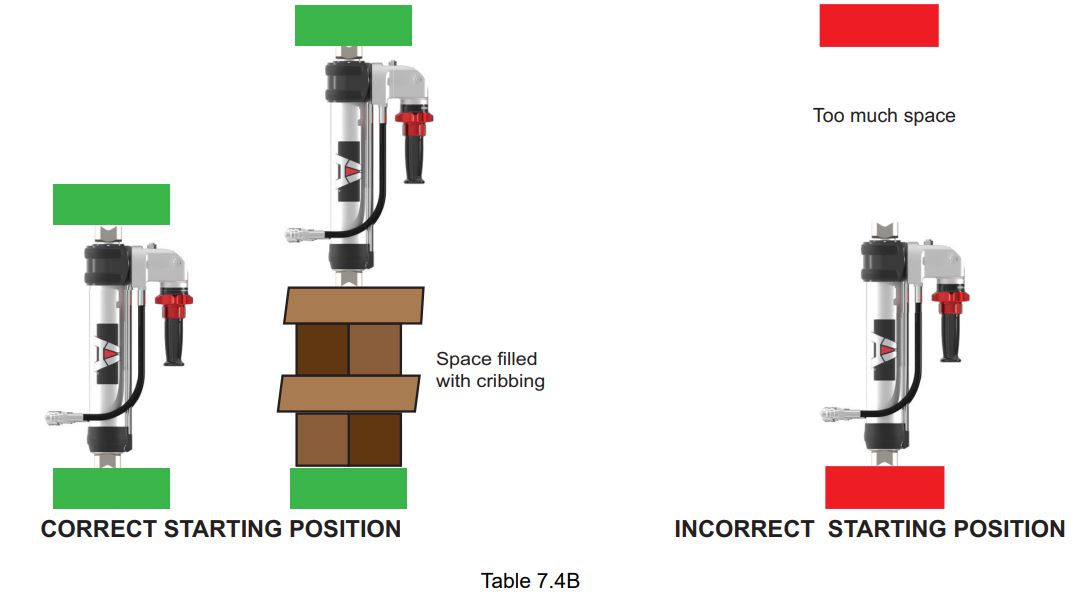
8.0 ACCESSORIES
8.1 EXTENDED REACH SPREADER TIPS (ERT)
The spreaders use removable tips. To remove the spreader tip, use a thumb and finger to depress the spring loaded tip pins, and remove the tips. To re-install the spreader tip, slide the tip back into place. Be sure that both pins return fully to their original positions. The reach and versatility of the spreader can be increased by using the Extended Reach Tips (ERT). ERT tips are interchangeable with the standard tips.
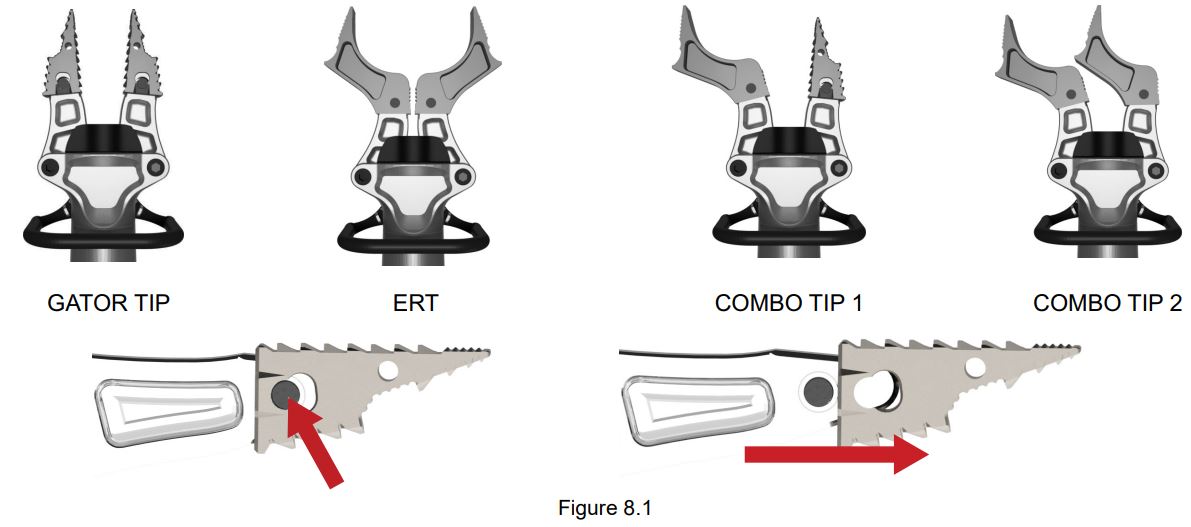
8.2 CHAIN USE
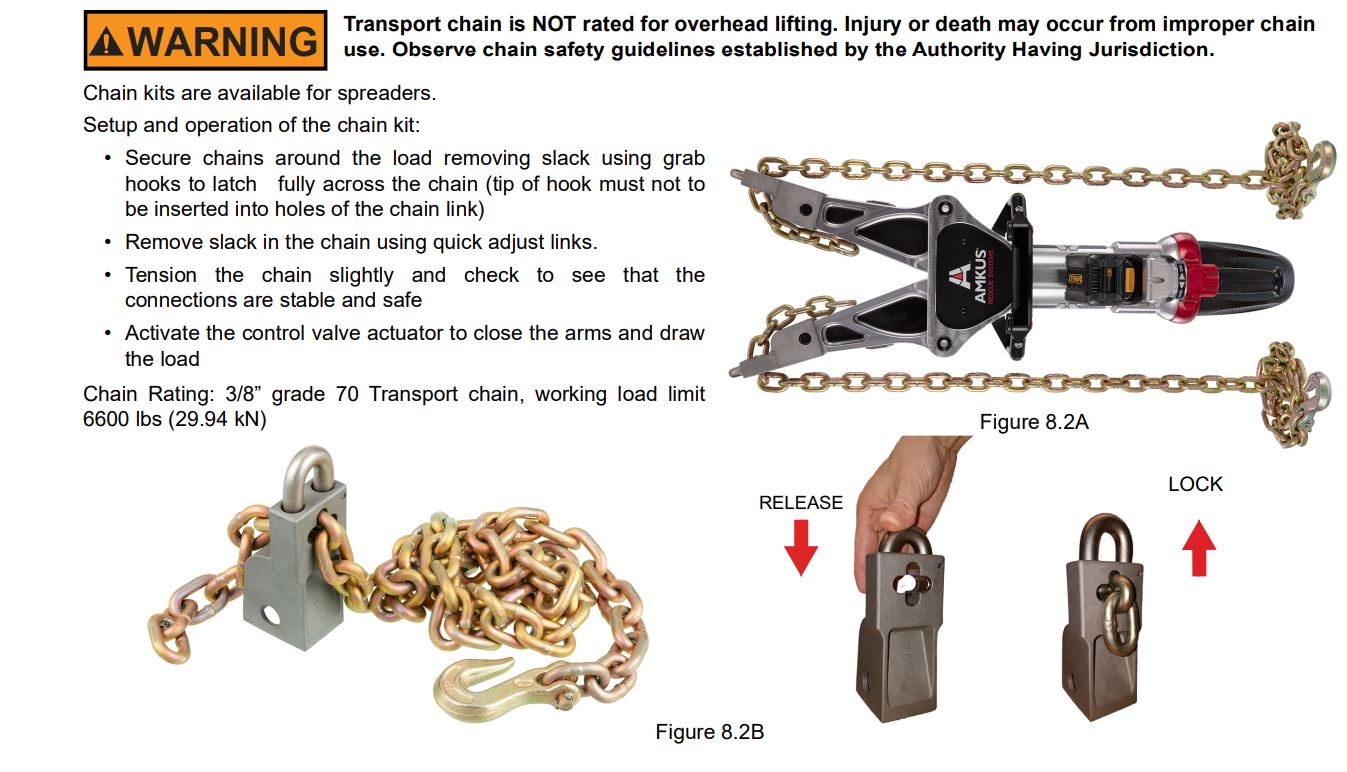
9.0 SAFETY GUARDS
Tools with moving blades have a guard over the moving parts. The guard is secured with screws which can be removed to clear debris during maintenance. Replace guards after maintenance.
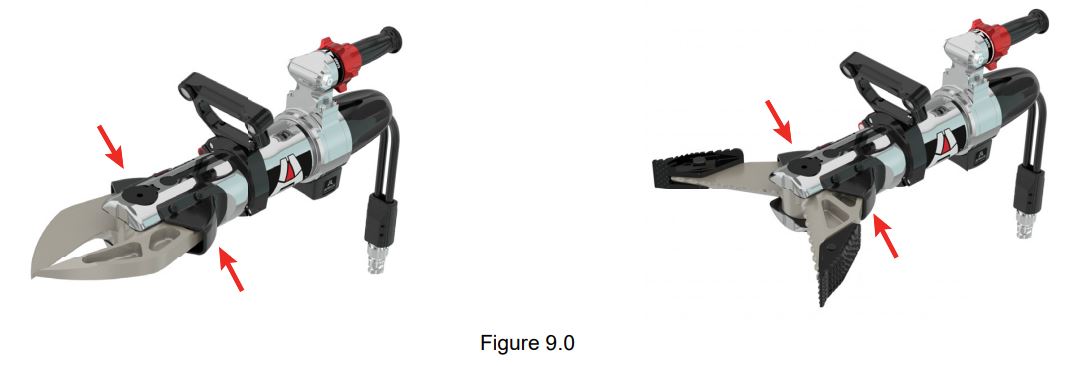
10.0 MAINTENANCE

![]() Perform all maintenance, inspection, and cleaning operations after the tool is cooled down to avoid injury or damage to the tool (see the Responsible Party in the maintenance schedule). Clean and inspect the tool before starting any maintenance work. Annual tool maintenance shall be completed regardless of how many hours the tool has been used since its last maintenance.
Perform all maintenance, inspection, and cleaning operations after the tool is cooled down to avoid injury or damage to the tool (see the Responsible Party in the maintenance schedule). Clean and inspect the tool before starting any maintenance work. Annual tool maintenance shall be completed regardless of how many hours the tool has been used since its last maintenance.
10.1 ROUTINE MAINTENANCE
10.1.1 CHECK THE BLADES
The use of damaged blades decreases the cutting efficiency of the tool and can overheat the tool. Replace the blades when they become worn, cracked, or gouged. (Consult AMKUS Rescue Systems) Check the torque on the cutter & combination tool pivot bolt monthly. Proper pivot bolt torque is 140 ft-lbs (190 N-m).
10.1.2 HYDRAULIC MAINTENANCE
Inspect the tool and hydraulic hoses for leaks. Inspect the hydraulic hoses and couplers for debris, damage, and proper operation. Replace any damaged components. Remove the tool from use if damaged. Contact your local dealer or amkus.com for repairs.
10.1.3 LUBRICATION
Cutter blades, combi blades, spreader arms, links, and pins are lubricated with white lithium grease. Annual re-lubrication is recommended for average service conditions. More frequent lubrication may be required for severe or frequent usage conditions.
10.1.4 HANDLE LIGHT BATTERY REPLACEMENT
To replace the batteries:
- Remove the lid screws with a 3 mm hex key.
- Remove and replace the 2 AA batteries in the battery holder.
- Use the hex key to tighten the lid screws back into position.

11.0 TROUBLESHOOTING
11.1 GENERAL
![]() Immediately remove malfunctioning or damaged tools from service. Consult your dealer or AMKUS Rescue Systems.
Immediately remove malfunctioning or damaged tools from service. Consult your dealer or AMKUS Rescue Systems.
ALL SERVICE MUST BE PERFORMED BY QUALIFIED SERVICE TECNICIANS IN OBSERVANCE OF SAFETY REGULATIONS.
Malfunctions can be divided into two sections:
- Malfunction of the hydraulic system
- Malfunctions related to other rescue tool systems
Remedies marked by the letter M require the intervention of the Maintenance Technician.
Remedies marked with the letter O can be performed by the Operator.
11.2 TROUBLESHOOTING THE HYDRAULICS

12.0 PARTS, SERVICE, AND TECHNICAL INFORMATION
Parts, service, and technical information may be obtained from your local AMKUS dealer, or at amkus.com.
13.0 DECOMMISSIONING
When decommissioning any AMKUS Rescue Systems Tool or power supply, follow local regulations. For proper disposal information, contact your local AMKUS Rescue Systems dealer.
14.0 INSPECTION, CLEANING, DECONTAMINATION, AND STORAGE
1. Always store the tool securely in a clean, cool, dry space.
2. Relieve the pressure on the tools after use by backing off the end stop.
BEFORE BEING PLACED BACK IN SERVICE, the rescue tool must be inspected to this list:
- Check to see that all rescue tool markings are legible. Contact your local dealer or AMKUS Rescue Systems for replacement labels.
- Wipe the tool clean.
- If the rescue tool becomes contaminated, determine the nature of the contamination. Follow the decontamination guidelines provided by the Authority Having Jurisdiction. Technical advice may be requested from AMKUS Rescue Systems.
- Inspect the tool, controls, and hoses after each use for damage, leakage, and excessive wear.
- If rescue tool damage or excessive wear is noticed, remove the rescue tool from service immediately.
Contact your local dealer or AMKUS Rescue Systems for service. - Attach the hydraulic power unit and verify tool operation.
![]() Any equipment failing any part of this checklist is unsafe for use and must have the problem corrected before use or being placed back in service. Operating equipment that has failed the checklist is a misuse of this equipment. Contact your local AMKUS dealer or AMKUS Rescue Systems.
Any equipment failing any part of this checklist is unsafe for use and must have the problem corrected before use or being placed back in service. Operating equipment that has failed the checklist is a misuse of this equipment. Contact your local AMKUS dealer or AMKUS Rescue Systems.
AMKUS RESCUE SYSTEMS
AMKUS.com
4201 Montdale Drive, Valparaiso, IN 46383-4098 USA 800-592-6587 · 219-548-5000
LAL-001 November 15, 2021 Rev04
Download PDF
AMKUS TR500 Hydraulic Rescue Tools User Manual PDF Download
